An increased use of computers was arguably the single most significant development for Disney animation during the 1980s. Computer assisted animation had kept costs more or less under control for The Great Mouse Detective and Oliver and Company, helped with several of the effects shots in The Little Mermaid, and provided one of the few aspects anyone in the animation department was willing to remember about the hell that had been The Black Cauldron. Up until the very end of the decade, however, computer assisted animation was only used for selected shots and effects.
That was about to change with The Rescuers Down Under, an otherwise forgettable film that formed a Disney milestone: it was the first Disney animated film to use the Computer Animation Production System throughout the entire film.
For this experiment, the producers chose to stick with something relatively safe—a sequel to the 1977 The Rescuers. Disney had, granted, never made a sequel to any of its animated films before this, but The Rescuers had been one of their few box office successes during their doldrum years of the 1970s and 1980s. The ending to The Rescuers had also left open the possibility for more adventures—indeed, prior to making the film, Disney had been toying with the idea of making an animated cartoon show based on The Rescuers. That show ended up becoming Chip ‘n Dale Rescue Rangers, leaving The Rescuers sequel free to play with the new possibilities offered by computers, specifically something called the Computer Animation Production System.
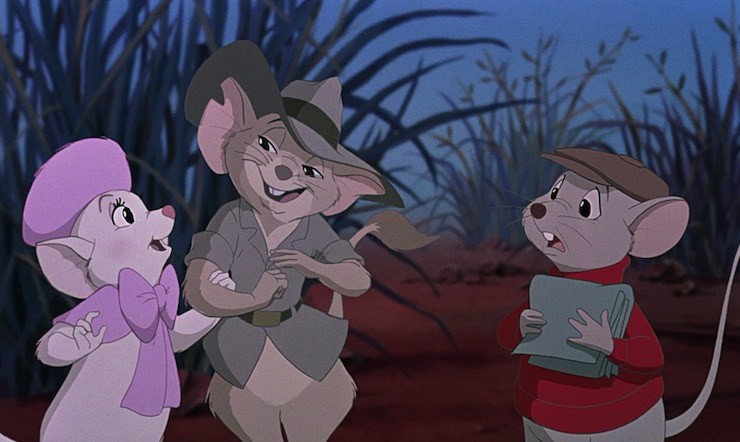
The Computer Animation Production System, or CAPS for short, was used to digitally ink and color all of the animated cels. It completely eliminated the need for hand inking or hand coloring, except for single animation cels produced to sell at various Disney art stores. It also allowed animators to create zoom effects—something that had been difficult to achieve in previous animated films—things that looked like live action tracking shots, and multiplane camera shots without the use of a multiplane camera. And, most importantly from Disney’s point of view, it meant that The Rescuers Down Under and subsequent films could be made for considerably less money; it’s estimated that the CAPS probably saved Disney about $6 million in development costs for The Lion King alone.
CAPS was not, however, a Disney invention. It had been developed by a small firm called Pixar, recently spun off from Lucasfilm (in 1986, in the aftermath of George Lucas’ financially crippling divorce), which had recruited (by some accounts) or outright stolen (from other accounts) computer scientists from the 1970s Computer Graphics Lab, at the time eager to create the very first computer animated film. Somewhat surprisingly, that computer animated film never emerged under George Lucas’ direction (surprising considering the heavy use of computer animation in later Star Wars prequels).
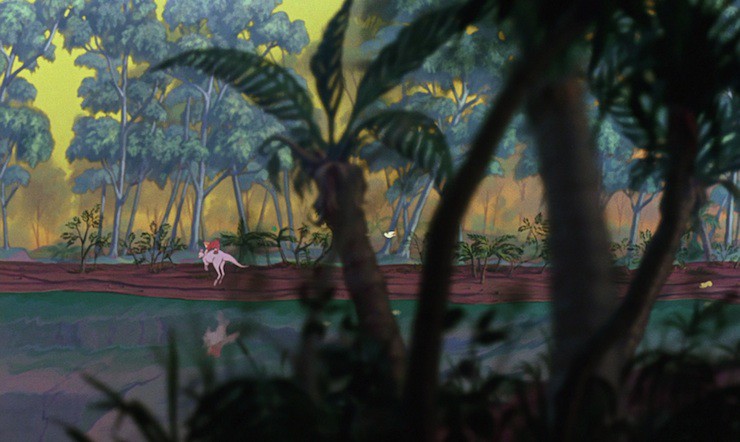
Instead, Pixar mostly spent the 1980s quietly dazzling artists with various small animated things—a tiny sequence in Star Trek: The Wrath of Khan, a short about a couple of lamps called Luxo Jr.—and snatching up animator John Lassester when he was fired from Disney for being too obsessed with computers. (It’s ok, computer geeks everywhere. There’s a very happy ending to this, I promise, even if that ending is several posts ahead.) With a computer animated short, and more or less stable financial leadership under Steve Jobs, Pixar was starting to contemplate abandoning its unprofitable hardware division to focus entirely on computer animated films. Something about toys, maybe. Or bugs.
Pixar’s full length computer animated films were a few years off, however, as was an extremely acrimonious dispute with Disney, which we’ll get to. For now, Pixar worked with Disney animators to create The Rescuers Down Under, experimenting with the process of combining hand and computer animation.
As a result of this, quite a bit of The Rescuers Down Under contains scenes that have no other purpose except to show off the CAPS process and what it could do—the opening zoom sequence where the camera zips across a field of flowers, for instance, or the sequence showcasing Miss Bianca and Bernard desperately running on spinning deep tread tires.
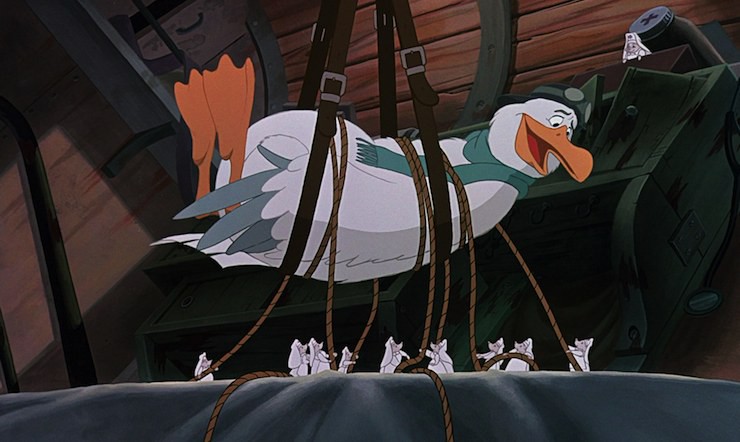
And that’s a bit of a problem—one that showcases the central issue of The Rescuers Down Under. It’s a film with a lot of plot, but not necessarily a lot of cohesive plot, continually flipping from one plot to another, creating multiple pacing issues. It’s not that the basic story—Miss Bianca and Bernard heading off to Australia to rescue an adorable kid kidnapped by an evil poacher—is bad. But the film keeps skipping here and there, never really connecting its characters until the final sequences, and often getting off track, as in a long and frankly unnecessary sequence where Wilbur the albatross is getting treated by various medical mice, which borders uneasily between comedy and horror, with bits that even John Candy’s generally hilarious voicing of Wilbur can’t make amusing. Plot holes abound: Bernard, for example, saves the eagle’s eggs with a clever trick that requires that a small mouse have the ability to carve eggs out of stone with his bare mouse paws in about, say, ten minutes. It’s not that Disney films are exactly known for their realism, but The Rescuers Down Under often wants to have it both ways: realistic depictions of the issues involved when three little mice go up against a Big Bad Human, and this.
The film also ends rather abruptly, leaving several unanswered questions, though it’s very possible that the creators figured they would be following this film up with another sequel. And I can’t explain a surprising lack of Australian accents in a film mostly set in Australia—one or two of the animal characters sound Australian, as does little Cody’s mother (mostly heard, not seen) and the very dashing kangaroo mouse Jake, apparently meant to be the mouse version of Crocodile Dundee. Everyone else sounds rather American.
Including the villain, poacher Percival C. McLeach. I can handwave the accent, partly because I can’t think of a reason why a poacher in Australia wouldn’t be American, and mostly because McLeach is American because he’s voiced by legendary actor George C. Scott, who explains that he didn’t pass third grade for nothing in gloriously strident tones.
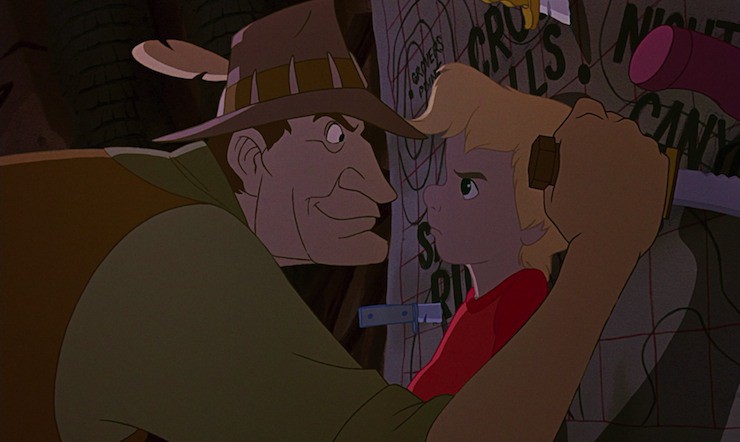
Trivial yet Titanic sidenote: George C. Scott later played Captain Edward J. Smith in the 1996 Titanic miniseries. Bernard Fox, who has a very small role in this film, had a brief cameo playing Colonel Archibald Gracie IV in the 1997 Titanic movie and earlier had an uncredited small role in the 1958 A Night to Remember, another Titanic film. I believe that makes The Rescuers Down Under the only Disney animated film, so far, to have two actors connected to three different Titanic projects.
Anyway. If I can let the accent go, I do, however, find myself raising an eyebrow at the actual villain, who despite Scott’s voicing, never quite manages to enter the ranks of the great Disney villains. Perhaps because on the one hand he’s too evil—beyond the poaching issue, he kidnaps and threatens a little kid, a pretty over the top reaction—and yet somehow not evil or powerful enough.
And because I’m not entirely sure that he really is the main villain here. The Rescuers Down Under dances around this, but the chief issue seems to be, not McLeach, but rather the complete helplessness of law enforcement not staffed by mice. Cody tells us, over and over, that the Rangers will get the poacher, and yet the only Rangers we end up seeing are the ones who (incorrectly) inform newscasters and his mother that little Cody has been eaten up by crocodiles. In general, they seem, well, not inept exactly—since, to repeat, we hardly see them—but absent or powerless. None of this would be happening, the film suggests, if the Rangers were doing their job.
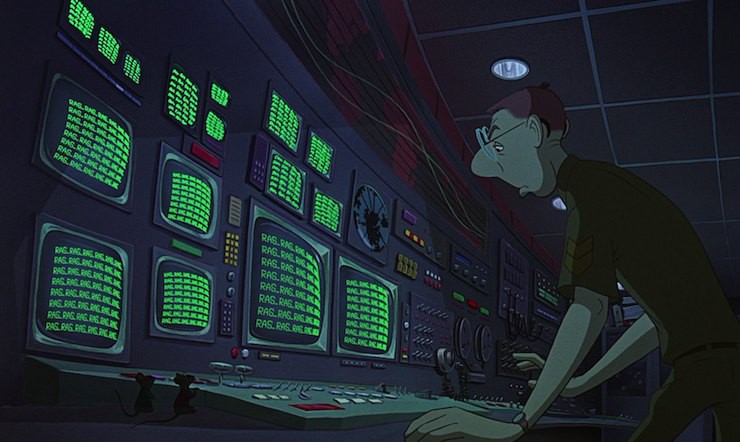
This is hardly the first time that Disney had created animated films with inept or missing police characters. In Robin Hood, for instance, the villains are—technically—the law enforcement. And many of Disney’s greatest villains exist in a world without a law enforcement capable of standing against them—Sleeping Beauty‘s Maleficent, for example, can only be taken down by magical creatures, not the royal armies. When the world does include capable law enforcement—One Hundred and One Dalmatians, for instance, or even The Jungle Book—the villains take active steps to avoid them. Here, although McLeach does kidnap Cody, his main motivation is not to prevent Cody from telling the Rangers everything, but to get information from Cody. And when Cody does escape, he notably doesn’t head to the Rangers, despite his repeated claims that the Rangers can shut McLeach down. He heads to the eagle’s nest alone.
Combine this with the sideline medical story, where the medical mice insist on treating an albatross and drugging him despite his protests, and how easy it is for the RAS mice to temporarily take over United States military communications, and The Rescuers Down Under presents, probably unintentionally, one of the most uneasy looks at the establishment since, well—since at least Robin Hood, and possibly ever in the Disney canon. Most strikingly, the film does not end—as did The Rescuers—with any shots showing Cody returning home with the help of authority figures, or with shots of the other kidnapped animals getting to return to their rightful places. Or at least a nice zoo. Instead, it ends with a number of loose ends, and John Candy’s voiceover telling us that, not only has the established order not been restored, he, an albatross, is still unhappily guarding an eagle’s nest and watching eggs hatch.
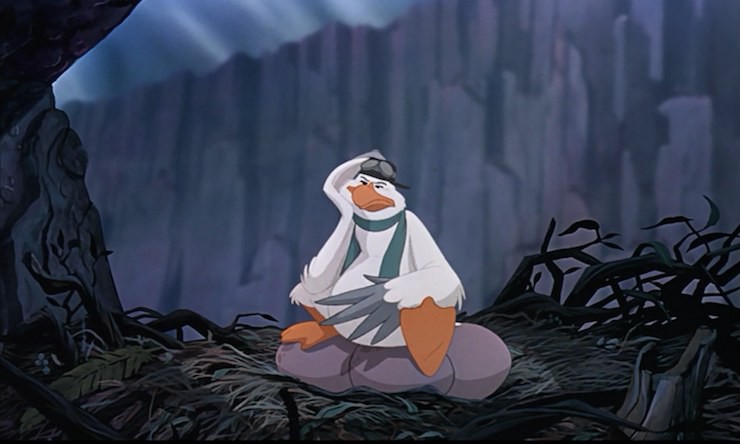
This isn’t to say that the the film doesn’t have a number of good or hopeful things. The romance between Miss Bianca and Bernard, here possibly threatened—gasp! by a very dashing Australian mouse—is still sweet and charming and remarkably adult. I’m a bit surprised that it’s taken Bernard what, 13 years to pop the question to such a charming mouse like Miss Bianca, but not at all surprised that his wedding proposal is generally used for bits of high comedy and pathos. It’s kinda difficult to propose, even in an elegant New York City restaurant, when you are constantly having to dash off and save people. Minor characters like a koala and a monitor lizard are comic delights. The bit where the Australian mice telegraph for help is fun, as is the sequence where mice around the world struggle to pass on the message—showing, by the way, that they could interrupt U.S. military procedures in Hawai’i whenever they want to, which is rather alarming, but let’s move on. I am very pleased to note that in the intervening years, Africa now has representatives from all of its countries; well done, RAS. (And Disney for correcting this.) Cody is considerably less annoying than the previous child in peril in The Rescuers. The bits where Cody rides the eagle—created through CAPS—soar.
But The Rescuers Down Under did not. It enjoyed only a tepid performance at the box office, possibly because it was competing against the wildly successful Home Alone. Flanked as it was by two far more successful Disney animated features, The Rescuers Down Under swiftly sank into obscurity, a little astonishing for a film whose innovative computer work was to form the basis for so much of Disney’s later animation.
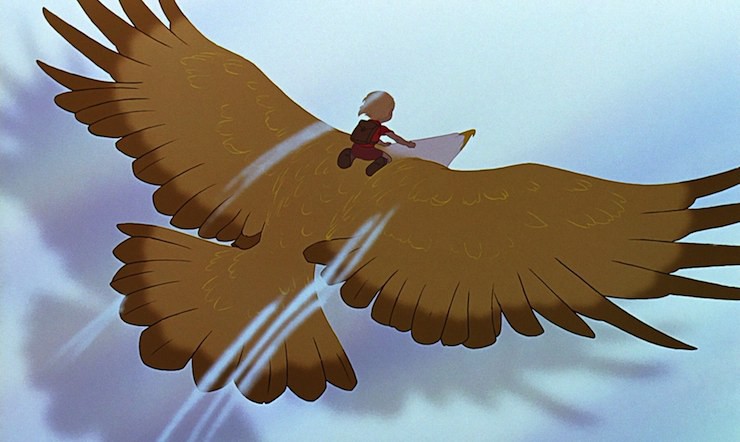
If the film itself sunk into obscurity, the computer programming techniques used to develop it did not. Indeed, a number of animators were already carefully studying its sequences, in between doodling pictures of little lions, soaring carpets, and—in 1990—a roaring, raging beast.
Next up: a little Christmas detour, followed by a break, before we return in the new year with Beauty and the Beast.
Mari Ness lives in central Florida.










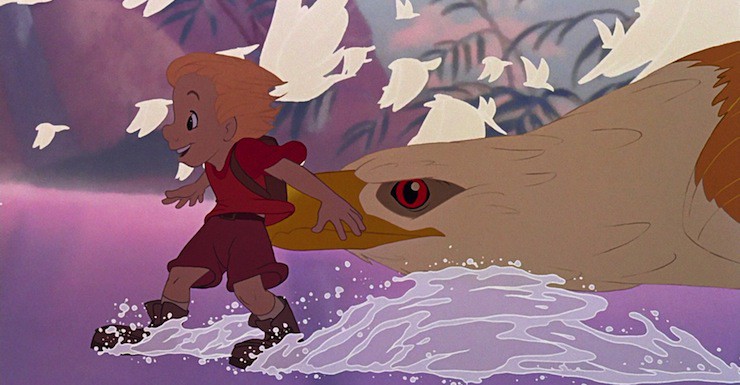
Always love your articles. You, Leah, and Emily make my Thursdays :D
I remember being BLOWN AWAY by that opening zoom across the grassy field. The difference between the look of this film and the first Rescuers is like watching my dad’s old 8mm films followed by the videos he took on that clunky Curtis Mathis camcorder (you know, the ones that had the fan on the side so you always heard that ssshhhhhhh sound?) Not to say 1980s SLP cassettes had fidelity of the highest order, but in comparison.
My sisters and I watched this flick when we were kids on VHS on a monthly basis (we didn’t have a lot of tapes), and we’d watched it before seeing the first rescuers. In fact, we were barely aware there was a first Rescuers. I recall learning (upon finally seeing it) that there was a different voice to the albatross, but that the voice actor playing Orville had died. THEN I learned that John Candy also died! It was a maturing moment.
And I always thought those egg-shaped rocks were just sort of… there. Like they fell out of a cliffside fully formed and smooth. Granted, it doesn’t explain how they’re perfect oblate spheroids when their nowhere near a river…
Also this movie has the same kind of “talking animal” logic that the Little Mermaid has. All the mice talk. Frank (the frilled lizard), the Koala, the Kangaroo that first summons Cody. They all talk in lovely Aussie (at least to my prepubescent ears) accents. But Marahute (the golden eagle), Joanna (the monitor), and that razorback boar that Bernard rides just make animal noises. Same went in Little Mermaid. Most every fish talks except for the dolphins that pull Triton’s chariot. Or maybe they do, but we just never hear them. Maybe there was a deleted scene where one of the dolphins turns to the camera, shrugs, and says, “Ehnn, it’s a livin'”.
Can’t wait for the next one!
Joanna isn’t a monitor lizard, she’s a goanna! That’s the best part. Joanna the goanna.
She was my favorite part of this movie when I was a kid. I would just rewatch her scenes and laugh and laugh.
ETA: And a quick googling tells me goanna is just another name for a monitor. But still. She should always be referenced as Joanna the goanna because rhyming.
I watched this movie a ton as a kid, and have a great deal of affection for it. It does have it’s problems and I think this is a pretty spot-on assessment of the movie, but I would like to mention that the musical score for this movie is absolutely beautiful, particularly the scene where Marahute and Cody fly together for the first time. The Rescuers Down Under theme is right up there in my mind with classics like Back to the Future and Star Wars (mostly for nostalgia reasons, but it really is beautiful).
I only ever remember three things about this movie: the majestic camera movements, Joanna’s antics, and… well, let’s call it what it was, even though I didn’t know what it was until over a decade later: a major crush on Jake.
I missed the issue about the accents though. French dubs generally don’t bother translating accent differences, so…
(And now that I have noticed a slight physical resemblance, I shall imagine that McLeach is related to Rourke from Atlantis The Lost Empire)
Heh. I never watched this one, or the original Rescuers film. Umpteen years ago, I read the first few pages of a picture book which began with Cody and Faloo the kangaroo going to free an eagle from a poacher’s trap, so I assummed that they were the Rescuers.
I’ll have to rewatch this film. It’s had to have been at least fifteen to twenty years since the last time, but I remember it very fondly. I can believe that it has its flaws, but it certainly wasn’t forgettable for me, aside from in the sense that it was an outlier from the string of fair-tales and princess stories that Disney specializes in. I suppose that the digitally-assisted thing was used to show off, but I just recall being awed by the beauty of the landscapes, and finding such moments to reinforce the emotional stakes.
I’ve really been enjoying these, especially the behind the scenes and business stuff. Any chance you’ll go into the afternoon cartoons, especially the early ones like Gummi Bears and Duck Tales, and their affect or how they were affected by the movies?
Yeah, I straight-up had no idea this existed, and the glory days of Disney from The Little Mermaid through to The Lion King literally constituted the soundtrack of my high school years. Great read as always, thanks!
I know you’re just doing full-length movies, but what I remember most about seeing this in the theaters was the twenty-minute short film that preceded it – “The Prince and the Pauper” starring Mickey Mouse! (I was so confused when the movie started and it wasn’t the movie I had been told we were going to see…) They took some liberties with Mark Twain, of course – mainly having the poverty being the fault of a particular villain, Captain of the Guard – Captain Pete was taxing everyone out of their food, and no one in the castle knew anything about it… There’s a grand finale scene where Mickey (the pauper) is dodging around trying to avoid being crowned king, and then the prince swoops in at the last moment and a battle starts up!
The prince’s advice to Mickey before stranding him inside the castle: “You only need to say two things. ‘That’s a splendid idea, I’m glad I thought of it!’ and ‘Guards, seize him!'”
________
I rewatched Rescuers Down Under a while ago and I was utterly appalled at the ending. The entire movie has been focused on saving Marahute and reuniting her with her eggs – even rescuing Cody transitioned into that second rescue – and rather than having the finale be a joyous reunion with her new babies, they went with a cheap gag about Wilbur being stuck on the nest getting attacked? Phooey.
The thing I find most odd about this movie is that it takes so long for Bianca and Bernard to show up. I developed this theory that maybe they started developing a different film and then decided the story wasn’t working, so reoriented the movie as a Rescuers sequel. I guess I was totally off-base
Narfna – I never once thought of “goanna” with this film. Just “monitor lizard”!
ubxs113 – No plans as of now to watch any of the Disney cartoon shows, although since many of the upcoming Disney films eventually had cartoon spinoff series, those will get mentioned.
Gummi Bears, of course, is important in this context, since it was Disney’s first successful multi-episode cartoon series, and thus helped lead the way for the Disney Afternoon cartoon slot, which in turn gave Disney the idea to make cartoon series from future Disney films.
Brenda A – The next post will be looking at a couple other Mickey Mouse shorts.
I’m glad you brought that up, though, because The Prince and the Pauper was the last Disney cartoon short made without the CAPS process, so bundling the last of the traditional ink/paint short with the first of the CAPS films makes a certain amount of sense.
BJ – Yeah, the pacing is odd there – but this was definitely always intended as a Rescuers vehicle. I guess the storyboarders/animators figured that it would help if this time, the kid needing rescue had a more interesting story.
I sometimes forget this one exists where it does – that Little Mermaid, Beauty and the Beat and Alladin didn’t come out right after each other. I don’t have a lot of memories of this as a kid. Agreed on some of the overdone slapstick though.
This is, I’m unashamed to admit, one of my favorite Disney movies and I’ve always been sad that no one remembers it. Yes, there are better ones, but this movie is full of so much beautiful stuff – it really shows off just what CAPS could do (and did), and it made the original The Rescuers look… well, terrible by comparison. I saw this one first, too, so the original one always felt very cheap and not very good to me, even if Bernard and Bianca (and the villain) were all fun in it.
This movie’s animation is just so nice, though. And there’s all these funny little touches, and Bernard’s jealousy of Jake is wonderful. And John Candy is so abused in this movie, it just provides a constant source of amusement to me.
I love this article, however I have the need of explain that the stone eggs weren’t craved by the mouse… There is a moment in the same scene where one can see that the stone eggs are natural formations from the ceiling above the nest, exactly when the Komodo dragon hits that ceiling with his head.
CAPS was most definitely a Disney invention. Pixar developers built CAPS from scratch as contractors under Disney’s direction. They were chosen mainly because Disney wanted to use Pixar computer and who better to write code for the Pixar computers than Pixar itself?
The Prince and the Pauper, the last cel animated work from Disney, was released with the first CAPS-work from Disney. Also, the picture of the man standing in front of the monitors with green letters; isn’t this the first time a computer is portrayed in an animated Disney feature? In that case, a sign of things to come.
They also used CGI in The Prince and the Pauper, the only non-feature cel animation work to do so (I don’t think any cel animation was used in the obscure Oilspot and Lipstick).